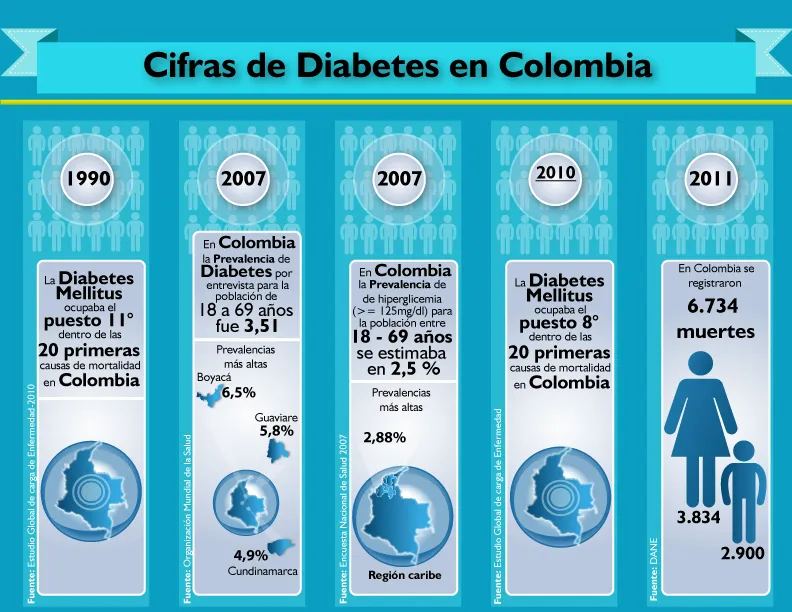“Sometimes I think that living with diabetes is like a conviction, as a punishment that deprives me of enjoying all the food that I like, but, at the same time, I have learned to live with this disease.Without a doubt, he has taught me to improve life habits, ”says Alexis Roldán Castro, who 9 years ago was diagnosed.
This 37 -year -old Barranquilla, a resident of the Las Palmas neighborhood, says that when he learned that his blood sugar levels - type 2 diabetes - were high, had the most bitter feeling of his life.
"I felt very sad, I began to think about all the repercussions that this disease would bring me," he says.
At that time, Alexis Roldán became part of 7.2% of Colombians suffering from diabetes, according to figures from the Diabetes Observatory in Colombia, ODC.
Walberto Buelvas, Monterian Diabetologist, says that this case has been valued through the halves rule.
“In the medical world of diabetes this rule says that there is a half of the population that does not know about the disease and that it also suffers from it, that is, in Colombia it is estimated that there are 2,300,000 diabetics, but there is also a half that does not knowThat is, ”explains Buelvas.
Current panorama.
Worldwide, Diabetes Atlas, in a 2014 study, confirmed that 382 million people suffer from diabetes and concluded that this figure is on the rise.At 2035 its growth will be 55%.
The International Diabetes Federation, FID, said, in a 2013 study, that urban residence is associated 5 times with more risk of diabetes than in rural areas.“64% of people with diabetes in the world live in cities.This means that living in the city increases by 70% the risk of suffering from this disease, ”says the study.
Growth in Colombia.
"Changes in food and reduction in physical activities are the main causes that lead to type 2 diabetes, which is acquired over time and is completely preventable," says tone.
Buelvas adds that years ago a type 2 diabetes could be developed when reaching old age, but currently the diabetics of this type are getting younger."That is because children learn to eat badType 1. "These are born and, very early in their life, they assume the difficulties of the disease," he says.
Diabetes costs. In Colombia, patients and health service entities are at a “crossroads,” says tone.He expresses that there are "very difficult to handle" elements, against which these institutions have to fight.
One of them is that diabetes is a chronic disease, that is, the diabetic is not cured.When it is fine, it comes into remission, but the only way patients improve is that, in addition to receiving medical treatment, "they change their life habits, which is difficult."
The Colombian Diabetes Observatory conducted a study on the resources of the health sector and the annual costs associated with the treatment of type 2 diabetes in this country and concluded that the expenses in screening, diagnosis, medical care and insulin therapy reach 7,327,000.
Likewise, indirect costs in the loss of productivity per year per patient is 1,051,000 and permanent disability in patients is 5,539,000. A possible dream.However, he insists that it is essential that these remain with good attitude, being disciplined in treatments not to get tired and abandon them.
The patient must be aware that the disease is devastating, but if it manages to make changes in their diet and starts constant physical activity routines can balance and control high sugar levels and keep stable health, far from the serious repercussions thatBring diabetes, add.
Therefore, Alexis Roldán affirms that his family's accompaniment has been fundamental.“My wife and children try to consume the same foods as me, so that it does not fall into temptation.His respect for my diabetes is my best insulin. ”
Symptoms and factors
• Abnormal thirst and dry mouth.
• Frequent urination
• Extreme tiredness and lack of energy.
• Constant appetite.
• Sudden weight loss.
• Slow in wound healing.
• Recurrent infections
• Blurred vision.
Although the reasons for developing type 2 diabetes are not yet known, there are several important risk factors.These are:
• Obesity.
• Bad food.
• Lack of physical activity
• Age.
• Family history of diabetes.
• Ethnic origin.
• Inadequate nutrition during pregnancy, which affects the developing child.


